Once upon a time, the Arts referred to entertainment:
There is no generally agreed definition of what constitutes art, and ideas have changed over time. The three classical branches of visual art are painting, sculpture and architecture. Theatre, dance and other performing arts, as well as literature, music, film and other media such as interactive media, are included in a broader definition of the arts.
Wikipedia – https://en.wikipedia.org/wiki/Art
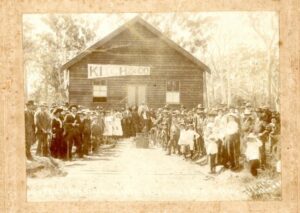
In Coffs Harbour
The purpose-built Coffs Harbour School of Arts was opened in September 1904, with a large ceremony attended by practically the whole town. In previous years from about 1897, an old slab school was used as a library and a general purpose meeting place.
The School of Arts was located on the north side of High St (now Harbour Drive), between Grafton Street (now the Pacific Highway) and Castle Street.
The building was revamped in 1908, which involved moving the building back 12 feet and adding a new front comprising a library and reading room on the ground floor and a smoking room upstairs.
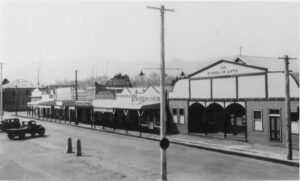
Initially the School of Arts was used for dances, balls, musical events, plays and public meetings. From 1912, motion pictures were shown, so the committee appointed Chas Dutton to be the full-time custodian.
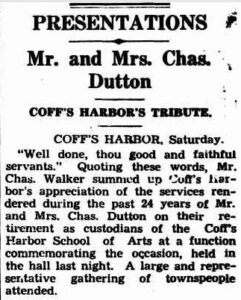
In 1919, the committee decided that a more permanent and regular showing of movies should be established, with films of Charlie Chaplin and a ‘6 reeler’ of Norma Tallmadge with pianist accompaniment. Two Pianists were also appointed to provide the weekly dance music, which they received the equivalent of $1.05 per night.
War-time meetings, farewells to enlisted men and welcomes of gratitude for returning veterans added much to the School of the Arts. The showing of movies remained popular throughout the 1920s. The School of the Arts made a quick transition to the ‘talkies’ showing its first talkie on Saturday 10th January 1931.
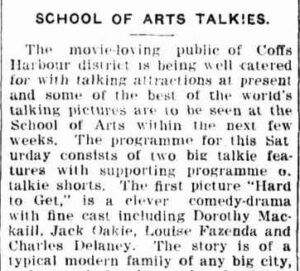
The trustees of the School of Arts decided they needed a more spacious hall and it wasn’t until 1927 that a re-build was arranged to accommodate functions like a Masonic Ball, a Hospital Ball and a Show Ball.
In 1935, the School of the Arts building was in such a dilapidated state that a meeting of its members chaired by the then President M.J.P. Hammond considered re-building. This was however delayed with only a £50 outlay for painting the front of the building which was agreed upon… a disgrace by all accounts.
As soon as the guttering around the School was pulled down by ‘peepers’, who had been climbing up the windows to view the pictures inside, a decision to remodel the building came up for discussion again in 1937.
Various committee members were appointed to make a detailed investigation of the dilapidated Arts building, but nothing ever came of this. Mr Charles Vost was the President at the time.
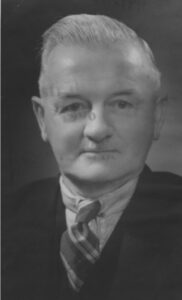
Soon after the outbreak of World War II, a meeting of the School’s members recommended that it should be handed over to the Dorrigo Shire Council, with the object of having a Town Hall and Shire offices built in lieu. The War put an end to all such ambitious plans for renovating the School of Arts. A further 24 years were to pass before it bowed out in favour of a Town Hall, built on a different site. During the first five or six post war years, the committee of the School of the Arts grappled with the problem of its then dilapidated building.
In 1947 an approach was made to the Shire Council offering to combine with the Council to erect a Civic Centre, with the understanding that the School of Arts would contribute funds from the sale of its High Street property, and the Council would incorporate a public hall, billiard room and library in a new centrally located complex, with Shire Chambers. In 1948 this proposal to combine with the Council failed.
Subsequently, a proposed new 20,000 two-storied brick building received consideration and President Vost obtained Ministerial approval for it from the Department of Education in Sydney. Two months later a building committee was appointed. (Meeting minutes from various 1940s School of Arts committees are available in Coffs Collections.)
A proposal also in 1948, to have the frontage of The School of Arts converted into shops for letting, advanced another step in 1950 when that was approved and a loan from the National Bank of Australia of £3,750 were forthcoming. A fresh fruit and vegetables shop, a dry cleaners, a Library and a lottery ticket sales shop then graced the front of the building.
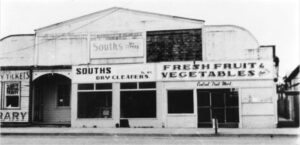
The demise of the School of Arts premises took place in 1958, when it was finally realised that the property was recognised as over-capitalised in relation to the income being derived from it. Being located in the heart of the shopping centre, the site had great commercial value.
Woolworths, with an offer of £56,500, purchased the property in 1960. The offer was accepted. [1] A new venue was constructed elsewhere.
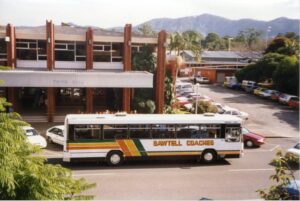
In Woolgoolga
Well ahead of Coffs Harbour, the Woolgoolga School of Arts was built in the 1890s to serve the social and cultural needs of the community. Although it was a poorly built wooden structure, it served for several years as the main venue for concerts, dances and a library. Catholic Masses were also held there with record congregations.
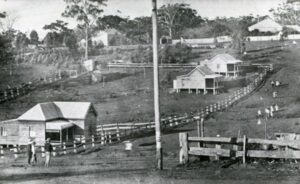
The Woolgoolga School of Arts had a fairly short life, according to Otho Alverson – bushworker, who settled in Woolgoolga in 1889. Otho recalled attending the dances which were held regularly there, with a single admission charge of one shilling. Each month a Ball was held and tickets for admission was three shillings and six pence for a double. People came on horseback from Corindi, Halfway Creek, Glenreagh and Bucca Creek to attend these functions at the School of Arts.
One of Woolgoolga’s residents, Ernie Younger, remembers starting school in 1907 having to move first into the School of Arts while a new school was built between the Black Tracker’s Hut and the Police Station. [2]
The Department of Education rented the School of Arts for five shillings per week to conduct glasses there. It was officially vacated by the Department on 31st December 1908 when the lease ended.
During the 1920s, the School of Arts was pulled down and any useful timber went to the building of a house next to a store in Beach Street. The store was still standing in 1981, but the house was removed in about 1971. School tennis courts now occupy the grounds where the School of Arts once stood.
In Coramba
The Coramba School of Arts was built in Gale Street in 1912 on land donated by William Gale. As it was nearing completion it was physically moved back and a Coffee Palace was added fronting the Street.

It became the centre of the town’s social life for many years, having its own band and at time featured a Black and White Minstrel Band with stringed instruments. Three act plays were also featured. Madame Melba, Dame Clara Butt, Slim Dusty and Ada Crossley were some of the visiting artists to remembered from early times.
School concerts were an annual event as were Debutante Balls. In 1918 a benefit was held for a family affected by a mill accident. A few years later an Amateur Theatrical Society called “The Cats” appeared. Old timers recall ‘good shows’ being performed at the School.
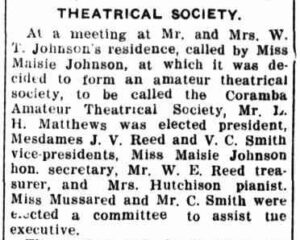
SUCCESSFUL FUNCTION. On Saturday night last in the local School of Arts, a dance and concert were held in aid of the candidature of Miss Doreen Shone in the local queen competition. Mr. Les Evans, of Grafton, was mainly responsible for the thoroughly happy time enjoyed by all and also for the several concert items supplied by a party he brought from Grafton. The attendance was one of the best seen in Coramba for a considerable number of years. Molly Tomlinson, of Grafton, contributed a sword dance and the Highland fling to the accompaniment of Mr. P. McPhee with the bagpipes. Later in the night Molly again appeared on the stage, but this time recited “If.”
Mr. Les Evans greatly amused the audience with “Larrikin Tom.” “Larrikin Tom” was a huge doll, and Mr. Evans, who is an excellent ventriloquist, had everyone in the hall rocking with laughter. The orchestra consisted of Messrs.- P. Matheson, sen. (international accordion), Mr. P. Matheson, jun. (piano-accordion) and Mr. J. McPhee (drums). This orchestra was also brought from Grafton by Mr. Evans.
CORAMBA (1936, July 29). Daily Examiner (Grafton, NSW : 1915 – 1954), p.8
The functions were very successful, both from a social and financial point of view.
In Bonville
Research indicates that the old community hall (pictured below), and the School of Arts building are one and the same. The public hall still stands, near Ayrshire Park Drive.
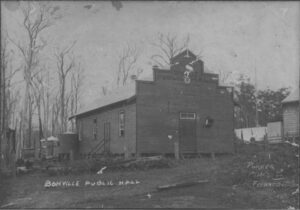
Researched by Martin Jeffery – volunteer – Coffs Harbour Regional Museum 2008
Images from Coffs Collections in 2022.
References
[1] Coffs Harbour Vol II 1946 – 1964, Yeates, 1990.
[2] Woolgoolga, the history of a village, mid-north coast, Yeates, 2013
